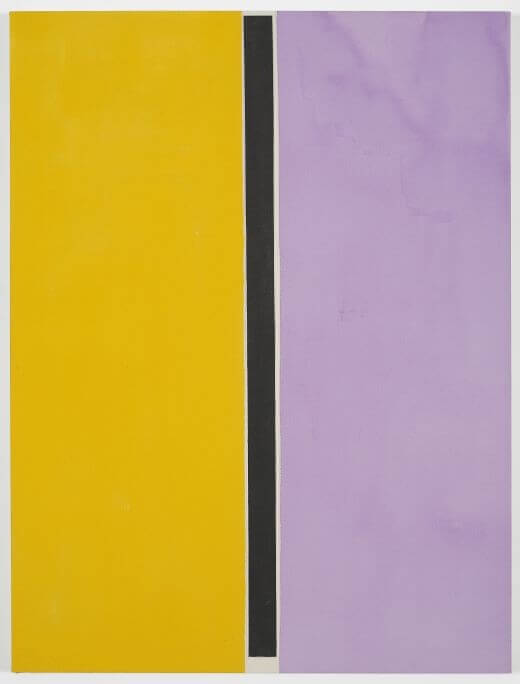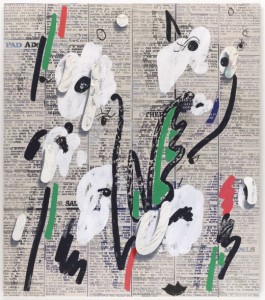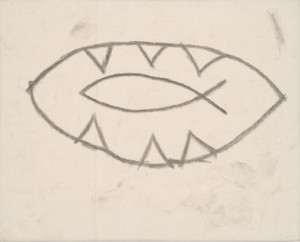Zombie Paintings at MoMA
Daniel A. Siedell

Matt Connors, Divot, 2012. Acrylic and pencil on canvas, 121.9 × 91.4 cm. Collection Richard and Monica Weinberg. Courtesy Herald St, London. Photo: Andy Keate
Painting seems to have returned from the dead, again. The frequent pronouncement that painting is dead, followed by the declaration of its eventual resurrection, is an important, but often overlooked part of the modern (and postmodern) artistic tradition. Since the late nineteenth century, with the advent of other imaging technologies (such as photography) and the desire to make works of art that can participate in and connect to the shifting social conditions and new emotional complexities of modern life, artists and critics have fought either to justify painting’s existence in a changing world or to kill it off once and for all. And so some of the most inflated rhetoric about painting as well as the most insightful and profound critical commentary in the twentieth century has been a response to the abiding fear that, compared to other artistic and creative cultural practices like photography, film, digital imagery, installation, and performance, painting is irrelevant to our daily emotional and imaginative lives.
To drag a brush loaded with smelly pigments across a scrap of canvas is indeed a vulnerable, fragile, and even absurd cultural practice—absurd not only for its maker but for one who stands before its finished product. A painting’s value as a highly sought-after and collectible luxury item does very little to alleviate the need for artists and critics to justify its existence beyond the auction houses and art fairs. Thus, what lies just barely below the surface for both is Gerhard Richter’s observation that “painting is pure idiocy.” 1 Forever Now: Contemporary Painting in an Atemporal World, on view at the Museum of Modern Art (MoMA) through April 5, proclaims once again that painting has returned from the dead.
But this time, something is different. It should come as no surprise that, since its founding in 1929, MoMA has been the site of many (if not most) claims of painting’s resurrection. But it is also the case that many of its exhibitions have, in turn, served to pronounce its demise, at least implicitly. Even the most casual observer and irregular visitor to the museum is struck by the growing disconnect between the paintings in the permanent collection that are entombed in the fourth- and fifth-floor galleries and the noisy and bustling installations that are regularly on view on the more visible floors. To be sure, tourists continue to flock to take selfies in
front of Vincent van Gogh’s Starry Night (1889), Pablo Picasso’s Les Demoiselle d’Avignon (1907), Jackson Pollock’s Number 31 (1950), and Andy Warhol’s Campbell Soup Cans (1962), but these paintings seem to be hanging in state, having passed away long ago, and thus are no longer able to speak in a meaningful way to the one who stands before them.

Laura Owens, Untitled, 2013. Flashe paint, synthetic polymer paint, and oil stick on canvas, 349.3 x 304.8 cm. The Museum of Modern Art, New York.
Curated by Laura Hoptman, Forever Now is an attempt to confront this institutional disconnect with a display of painting’s quantitative power by seventeen artists (nine women and eight men). Critic Peter Schjeldahl observed that this is the same number of artists Alfred H. Barr Jr. included in MoMA’s landmark exhibition The New American Painting, which traveled across Europe in 1958–59 to show that although modern painting may have died there during World War II, it had been resurrected in New York with Abstract Expressionism. 2 Forever Now is a hustling, bustling, claustrophobic, and distracting exhibition, not only because nearly one hundred works are crammed into the relatively small exhibition spaces on MoMA’s sixth floor, but also because it creates the impression that the paintings should not (cannot?) be viewed or experienced individually, but only as a part of a continually growing and endlessly accumulating installation that overwhelms and dazzles the viewer with its sheer visual volume and diversity.
Some reviewers have criticized Hoptman’s selection of painters as a pretty standard lineup of established and market-safe artists, especially some of the women, like Julie Mehretu, Laura Owens, and Amy Sillman, who have been working successfully for a number of years. 3 But such criticism, implying that Hoptman needed to discover new artists working in new ways, or uncover a new collective movement with fresh faces, is unfair. Forever Now offers an exhibition of paintings by artists who do not believe painting needs to be defended, either by appropriation, irony, or as a conceptual strategy, and have been busy about the practice of painting for many years. In her catalogue essay, Hoptman quotes Sillman, who, in the audience at a symposium some time ago on the “problem of painting,” declared, “What’s the problem? Painters don’t see any problem.” 4
The show is therefore also a confident and even exuberant presentation. It is indeed refreshing to look at artifacts produced by artists who don’t feel the need to apologize for making paintings, who don’t make paintings in scare quotes, with a nod and a wink, and a “we all know what this means” look—strategies that characterized the practices of artists working in the 1980s and 1990s. Matt Connors’s large painted panels, Rashid Johnson’s scrawled, looping lines on black soap and wax, Dianna Molzan’s playful use of stretchers and frames, and Mary Weatherford’s saturated abstractions adorned with neon lights are just a few examples of works that embody this freedom and confidence.
The refreshing confidence and exuberance of many of the Forever Now artists reveal a problematic side to the thesis of Hoptman’s exhibition. If the quotations from the artists that she includes in her catalogue essay are an accurate representation, it appears that she and they do not fully grasp painting as a precarious and vulnerable practice, or feel the impact of the threats to its existence that it has regularly faced for over a century. In
other words, they understand the history of modern painting as merely a progress succession of formal innovations and styles. They seem unaware of the deeper existential challenges that gave birth to such innovations and styles in the first place.
Oscar Murillo observes, “We have everything available and we can just use what’s there and around, but not feel concerned by it.” 5 What this “everything” is seems merely to be stylistic devices that signal “modern art history.” Hoptman herself speaks for the artists and their experience of the painting of the past: “yup, that happened. . .now there’s this.” 6 The virtue of the appropriation strategies, irony, “theory,” and even embarrassment
with painting that occurred during the 1980s and 1990s was that at least painting was recognized as having something epistemologically at stake, that it had to be fought for intellectually, that painting’s “pure idiocy” had to be dealt with. Although Hoptman’s artists claim an unrestricted freedom and agency, they reveal a lack of self-consciousness, both emotional and intellectual, that infects the exhibition. For Hoptman, freedom and agency amount to voracious consumption and production of artifacts, not self-reflection and a deepened consciousness.

Enid A. Haupt Fund; Joe Bradley, Abelmuth, 2008. Grease pencil on canvas, 101.6 x 152.4 cm. The Museum of Modern Art, New York, Gift of Adam Kimmel. Photos: Jonathan Muzikar
To make a claim for the resurrection of painting is not an empirical observation. It is rather an interpretive act that requires belief in painting. One of the reasons painting is forever on the edge is how difficult it is to talk about why it exists, not to mention its importance. It is one thing to stand before a painting. It is quite another to say something about its effect on you to a friend over coffee. Many of the most insightful commentators on modern painting have been painfully aware that what they say about paintings runs the risk of being even more fragile, absurd, and idiotic than the paintings themselves. Overstating painting’s significance and importance is always a temptation for the modern critic. But it is this continual threat of painting’s “death”—its conceptual, existential irrelevance to the emotional and imaginative life of the person who stands before it—that has energized not only studio practice but critics well. Painting needs justification, and the history of modern art is the history of critics, in the face of its irrelevance, offering creative justifications.
And so Forever Now must be understood in this context as offering another interpretive justification for the continued viability of painting. How does Hoptman justify painting’s resurrection? Prove that it is once again alive? Well, she doesn’t. Painting isn’t really alive for Hoptman. It’s just undead.
The cultural context and situation that Hoptman identifies as the justification for painting’s continued relevance is “atemporality,” a term that she takes from the science fiction writer William Gibson, by which “all eras seem to exist at once.” Hoptman continues: “The atemporal song, story, or painting contains elements of history but isn’t historical; it is innovative but not novel, pertinent rather than prescient,” neither “critical nor ironic, not even nostalgic.” 7 Hoptman connects atemporality to Saint Augustine’s notion of the “eternal present,” drawn from
the fourth-century theologian’s autobiographical Confessions, which she claims describes a “temporal state in which. . .the past and the future have been made available simultaneously.” 8 But Hoptman’s “eternal present” differs from Augustine in a significant way, and one that bears directly on Forever Now and the practice of painting. For the African theologian, this moment is possible only through an act of self-reflection that
does not eliminate the temporal or disintegrate the historical, but fulfills the precarious present and endows it with meaning as the embodiment of the past and future.
What Hoptman’s notion of atemporality and her interpretation of these seventeen artists included in Forever Now
misses is the important roles that consciousness, self-reflection, and even vulnerability play in the practice and experience of painting. There are some exceptions. Joe Bradley’s large, but stripped down, grease-penciled, and childlike images, including a cross and a stick figure; Michaela Eichwald’s dark and crusty compositions; and Mehretu’s smoky, monochrome markings seem sober and measured in a manner that invites a deeper relationship with them than do some of the other works in the exhibition.
Given her lack of attention to this precarious existential and experiential dimension of painting, it is not surprising, then, that Hoptman finds the zombie to be an appropriate metaphor for contemporary painting: “the undead are the perfect embodiments of the atemporal.” 9 She continues: “[the zombie] evokes the voracious hunger for ideas and images from the past that, in some paintings today, are consumed, digested, and re-presented in guises that resemble their original forms, but are somehow changed.” 10 But this voracious zombie-like hunger is profoundly unreflective, unselfconscious, and unable to experience the precariousness of human existence, much less the
precariousness of devoting a life to caring about pigments smeared on paper or canvas.
For Hoptman, painting will never completely die. And so contemporary painters simply shuffle along. But because they are unable to experience the “death” or even the “problem” of painting, these painters are also unable to experience this fragile medium as “alive,” as life-giving, life-affirming, experience it as a creative means by which they can possibly achieve more clarity about themselves and the world. But Forever Now also suggests that the zombie state of contemporary painting is as much an interpretive problem as it is a creative one. Contemporary painting deserves a critical framework that risks believing that painting is more than merely undead, but alive, and that the source of its life for the one who stands before it is generated precisely by its fragility and absurdity. That is a “pure idiocy” that I want to believe in.
DANIEL A. SIEDELL, PhD, teaches art history at The King’s College in New York and theology at Knox Theological Seminary in Fort Lauderdale.
1 Douglas Crimp, “The End of Painting,” October 16 (Spring 1981), 86.
2 Peter Schjeldahl, “Take Your Time,” New Yorker, Jan. 5, 2015.
3 Roberta Smith, “The Paintbrush in the Digital Era,” New York Times, Dec. 12, 2014), C27.
4 Laura Hoptman, Forever Now: Contemporary Painting in an Atemporal World (New York: Museum of Modern Art, 2014), 23.
5 Ibid., 15.
6 Ibid.
7 Ibid., 14.
8 Ibid.
9 Ibid., 24.
10 Ibid.










